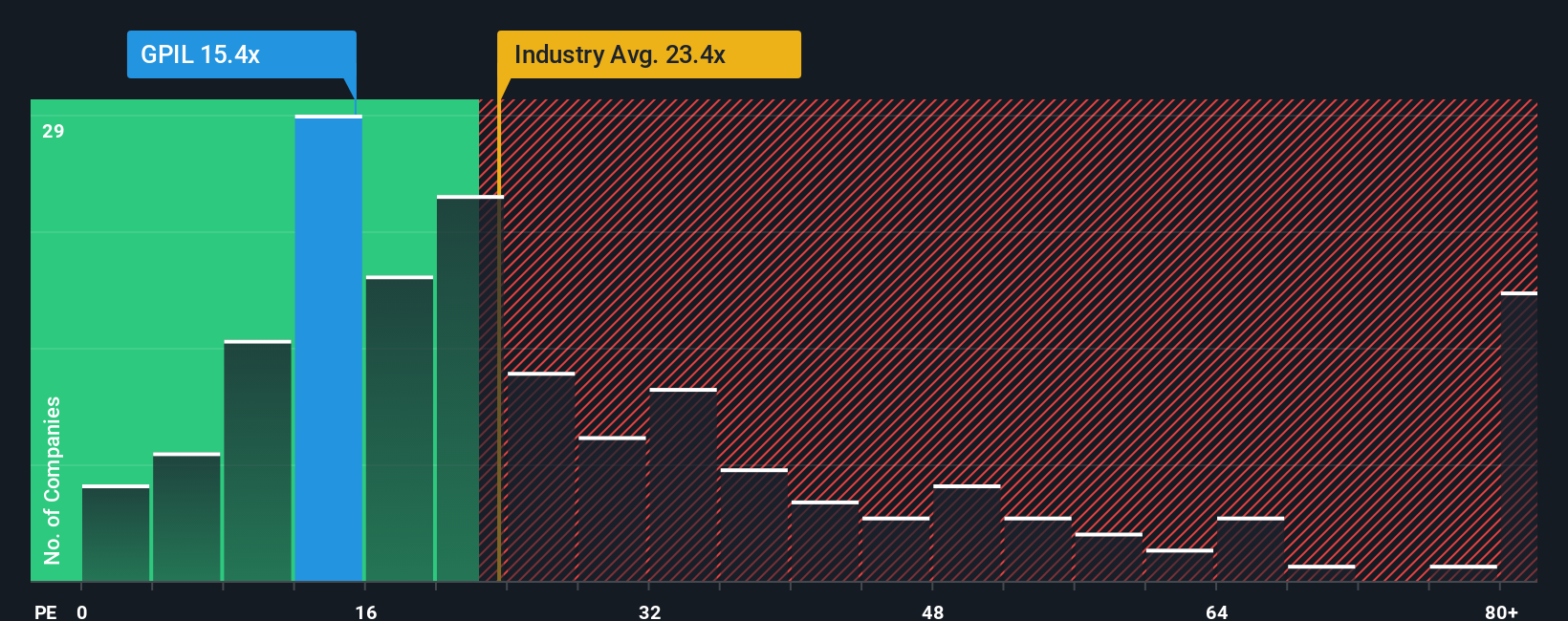- India
- /
- Metals and Mining
- /
- NSEI:GPIL
Not Many Are Piling Into Godawari Power & Ispat Limited (NSE:GPIL) Just Yet
Godawari Power & Ispat Limited's (NSE:GPIL) price-to-earnings (or "P/E") ratio of 15.4x might make it look like a buy right now compared to the market in India, where around half of the companies have P/E ratios above 31x and even P/E's above 58x are quite common. However, the P/E might be low for a reason and it requires further investigation to determine if it's justified.
Godawari Power & Ispat could be doing better as its earnings have been going backwards lately while most other companies have been seeing positive earnings growth. The P/E is probably low because investors think this poor earnings performance isn't going to get any better. If you still like the company, you'd be hoping this isn't the case so that you could potentially pick up some stock while it's out of favour.
Check out our latest analysis for Godawari Power & Ispat

What Are Growth Metrics Telling Us About The Low P/E?
In order to justify its P/E ratio, Godawari Power & Ispat would need to produce sluggish growth that's trailing the market.
Retrospectively, the last year delivered a frustrating 12% decrease to the company's bottom line. As a result, earnings from three years ago have also fallen 44% overall. Accordingly, shareholders would have felt downbeat about the medium-term rates of earnings growth.
Shifting to the future, estimates from the sole analyst covering the company suggest earnings should grow by 24% per annum over the next three years. With the market predicted to deliver 22% growth per year, the company is positioned for a comparable earnings result.
With this information, we find it odd that Godawari Power & Ispat is trading at a P/E lower than the market. Apparently some shareholders are doubtful of the forecasts and have been accepting lower selling prices.
What We Can Learn From Godawari Power & Ispat's P/E?
It's argued the price-to-earnings ratio is an inferior measure of value within certain industries, but it can be a powerful business sentiment indicator.
We've established that Godawari Power & Ispat currently trades on a lower than expected P/E since its forecast growth is in line with the wider market. When we see an average earnings outlook with market-like growth, we assume potential risks are what might be placing pressure on the P/E ratio. It appears some are indeed anticipating earnings instability, because these conditions should normally provide more support to the share price.
And what about other risks? Every company has them, and we've spotted 1 warning sign for Godawari Power & Ispat you should know about.
Of course, you might find a fantastic investment by looking at a few good candidates. So take a peek at this free list of companies with a strong growth track record, trading on a low P/E.
New: Manage All Your Stock Portfolios in One Place
We've created the ultimate portfolio companion for stock investors, and it's free.
• Connect an unlimited number of Portfolios and see your total in one currency
• Be alerted to new Warning Signs or Risks via email or mobile
• Track the Fair Value of your stocks
Have feedback on this article? Concerned about the content? Get in touch with us directly. Alternatively, email editorial-team (at) simplywallst.com.
This article by Simply Wall St is general in nature. We provide commentary based on historical data and analyst forecasts only using an unbiased methodology and our articles are not intended to be financial advice. It does not constitute a recommendation to buy or sell any stock, and does not take account of your objectives, or your financial situation. We aim to bring you long-term focused analysis driven by fundamental data. Note that our analysis may not factor in the latest price-sensitive company announcements or qualitative material. Simply Wall St has no position in any stocks mentioned.
About NSEI:GPIL
Flawless balance sheet with reasonable growth potential and pays a dividend.
Similar Companies
Market Insights
Community Narratives



